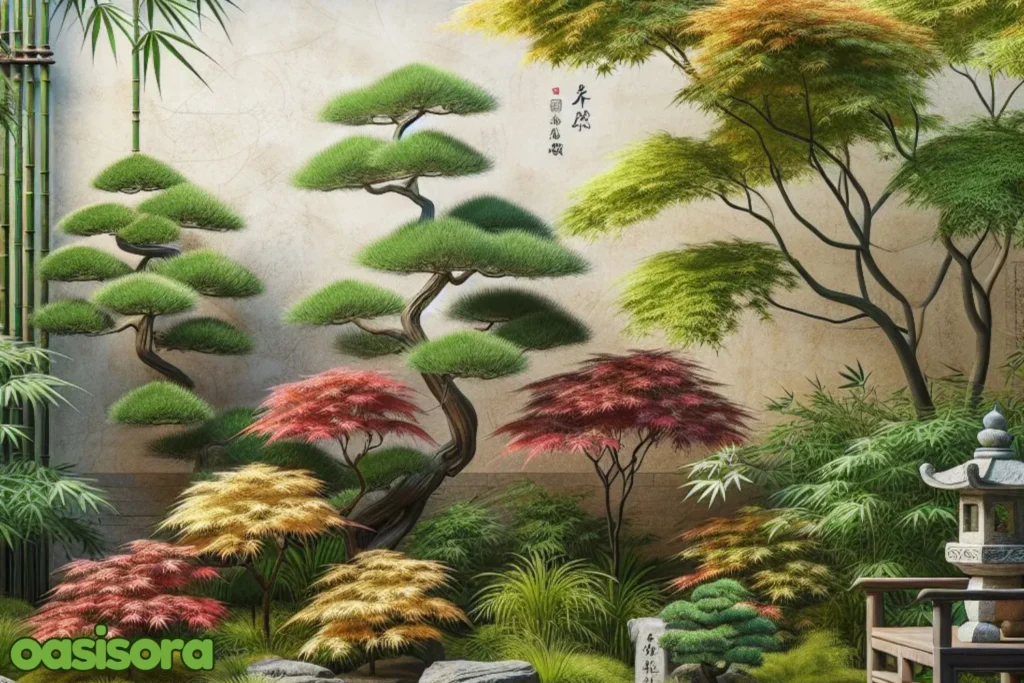
Creating Japanese gardens is easy. Low Maintenance Japanese garden plants flourish in many environments and need little care. They will help you create a calm space with little work.
Don’t worry if you don’t have much gardening experience. This guide will assist you in selecting the best plants and offer easy-to-follow maintenance instructions to keep your garden looking wonderful all year.
Top Low Maintenance Japanese Garden Plants
Maintenance of Japanese gardens is easy. If you have a busy routine and are afraid of your garden’s health, you should pick Japanese garden plants that don’t need much care and grow well with little effort.
Here are some of the best choices such as trees, shrubs, grasses, and perennials, to give your garden balance and variety.
1) Dwarf Japanese Maple (Acer palmatum ‘Compactum’)
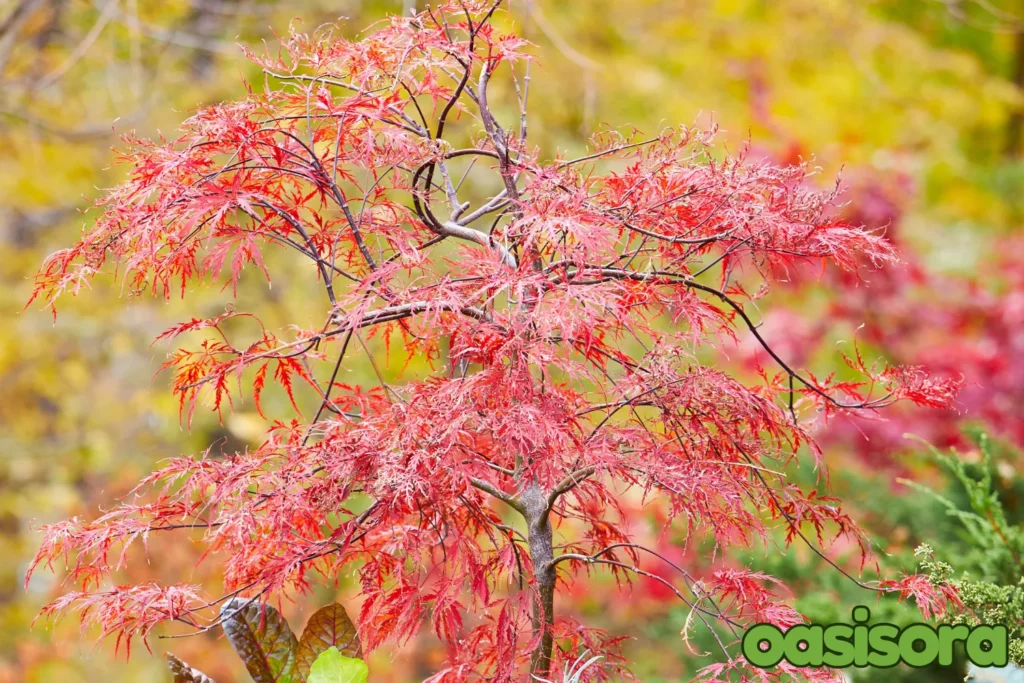
Japanese Maple
If you want a little tree, the Dwarf Japanese Maple is a fantastic choice. It looks great and doesn’t need much care. It’s excellent for small parks and patios; even placing it in pots is best.
This tree has beautiful color changes all year long. Its small green leaves look bright in the spring and summer. In the fall, they change their shades into red, orange, and gold and give your garden a magical look.
You can plant it next to rocks, ponds, or as the center point in your garden.
You must grow this plant because:
- It doesn’t get too big and fits well in small areas.
- Just let it grow freely because it doesn’t need much trimming.
- It needs very little water once it’s grown and can handle drought well.
- It likes some shade, especially when it is hot outside.
2) Japanese Forest Grass (Hakonechloa macra)
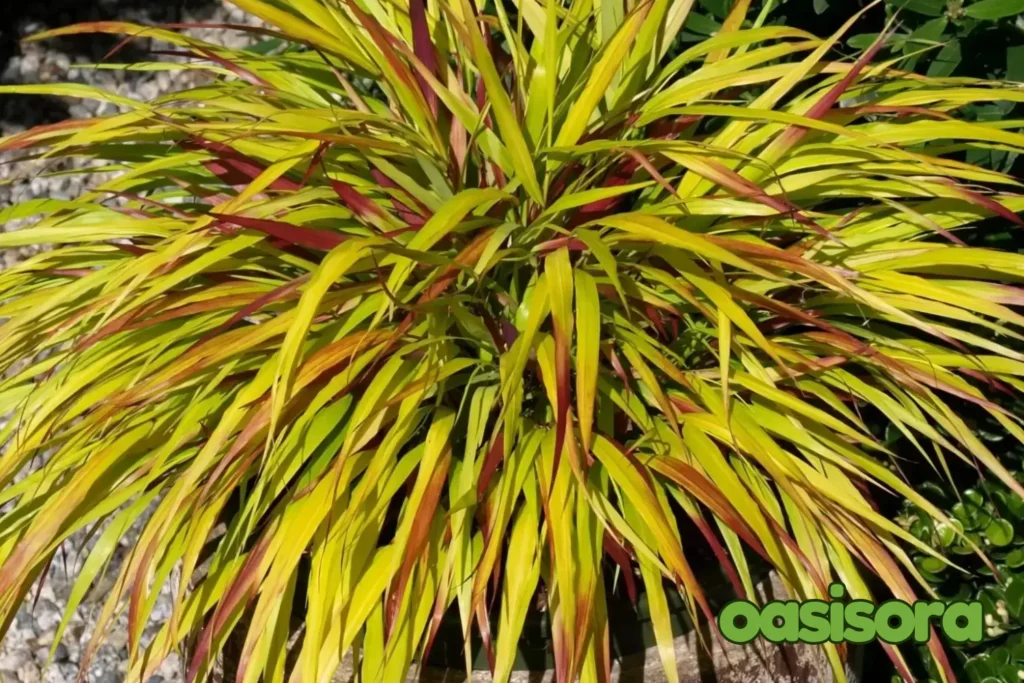
Japanese Forest Grass (Hakonechloa macra)
Would you like a plant that runs in your garden like water?. The best choice is Japanese Forest Grass. This pleasant, soft grass grows in a gentle curve, like a green waterfall.
This plant requires little maintenance. It looks after itself once planted and performs well in sunlight and shade. Placing it under trees, close to walks, or in rock gardens will provide your Japanese garden additional softness and depth.
You must grow this plant because:
- It requires little watering and can manage dry conditions.
- Growing in both sun and shade, it is flexible.
- You don’t necessarily have to cut it routinely.
- Although it can exist in various environments, it is sensitive to cold temperatures.
3) Azalea (Rhododendron spp.)
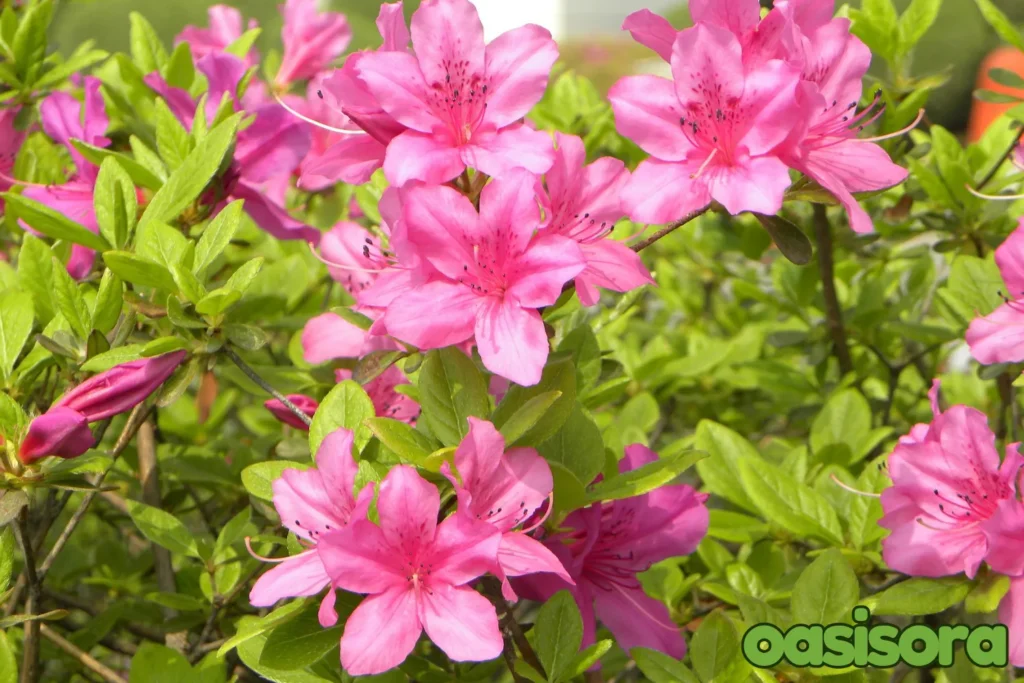
Azalea (Rhododendron spp.)
Azalea plants have vivid and bright flowers. If you add this plant, your garden will be illuminated in April when these bustling bushes blossom in pink, red, white, and purple.
Their simplicity of growing azaleas is the most remarkable feature. They require little maintenance and can live in many different temperatures. You can plant these low maintenance Japanese Garden plants along a road, next to a pond.
You must grow this plant because:
- Full sun or some shade is best for it.
- Just light trimming after growing.
- Easy to grow in soil that doesn’t stay soggy.
- It looks great by itself or in groups.
4) Nandina (Nandina domestica)
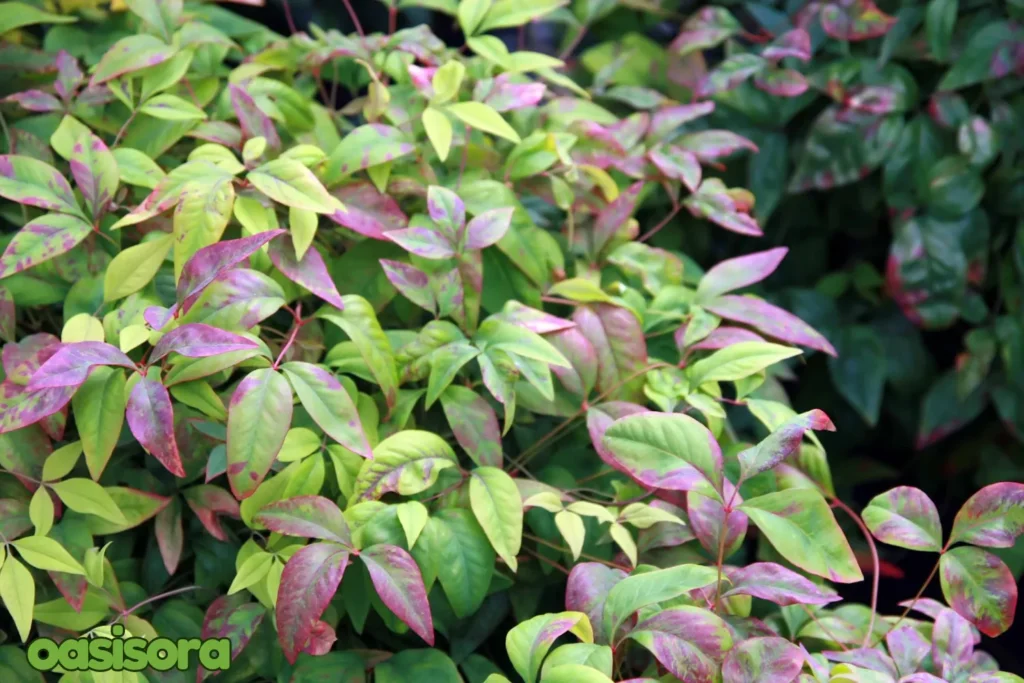
Nandina (Nandina domestica)
Nandina is a great choice if you want a plant that looks nice all year and doesn’t need much care. This hardy plant will help your garden look good all year long.
Although occasionally called the Heavenly Bamboo, it is not bamboo!. Its smooth and sophisticated appearance comes from its finely cut leaves.
When the leaves turn red and bronze, your garden will seem pleasant and fall-like in the winter. It’s especially more attractive in the winter when it bears bunches of vivid red berries.
Nandinai can be planted next to paths, rocks, or as a fence.
You must grow this plant because:
- It can grow in both full sun and light shade so that you can put it almost anywhere.
- Once it is grown, it doesn’t need much care.
- Doesn’t need chemicals and grows well in any soil that drains well.
- It doesn’t require particular care because it doesn’t get pests or infections.
5) Japanese Black Pine (Pinus thunbergii)

Japanese Black Pine
The Japanese Black Pine is advised for a striking and bold appearance. Extreme weather including wind, salt air, heat, and drought may all be handled by this robust tree.
Its dark green needles and twisted branches give it a bonsai-like appearance, which will bring out the natural Japanese environment in your garden.
It requires less maintenance than certain other trees. If you wish for a large, sculptural tree that shines out, this is a fantastic selection.
For a Japanese appearance, blend the Japanese Black Pine with rocks and soil or center it in your garden.
You can grow this plant because:
- It can handle dryness very well and doesn’t need to be watered regularly.
- No matter what kind of soil it is, it will grow.
- Able to handle rough weather and strong winds.
- Trimming is not necessary unless shape is required.
6) Japanese Pieris (Pieris japonica)

Japanese Pieris
Japanese Pieris is a great choice for an easy-care plant that stays green all year and changes color with the seasons. This plant remains green all year, but in the spring it gets new red or pink leaves that make it look even better.
It also has small white flowers in the shape of bells that add beauty without any extra work.
Japanese Pieris can be planted along paths, in flower beds, or as a small fence for a luxurious touch that looks great all year.
You can grow this plant because:
- It stays green all year, so you don’t have to replace it or place something new.
- It grows best in shade, but it can also handle some sun.
- It requires very little pruning.
- It grows well in soil that drains well.
7) Mondo Grass (Ophiopogon japonicus)
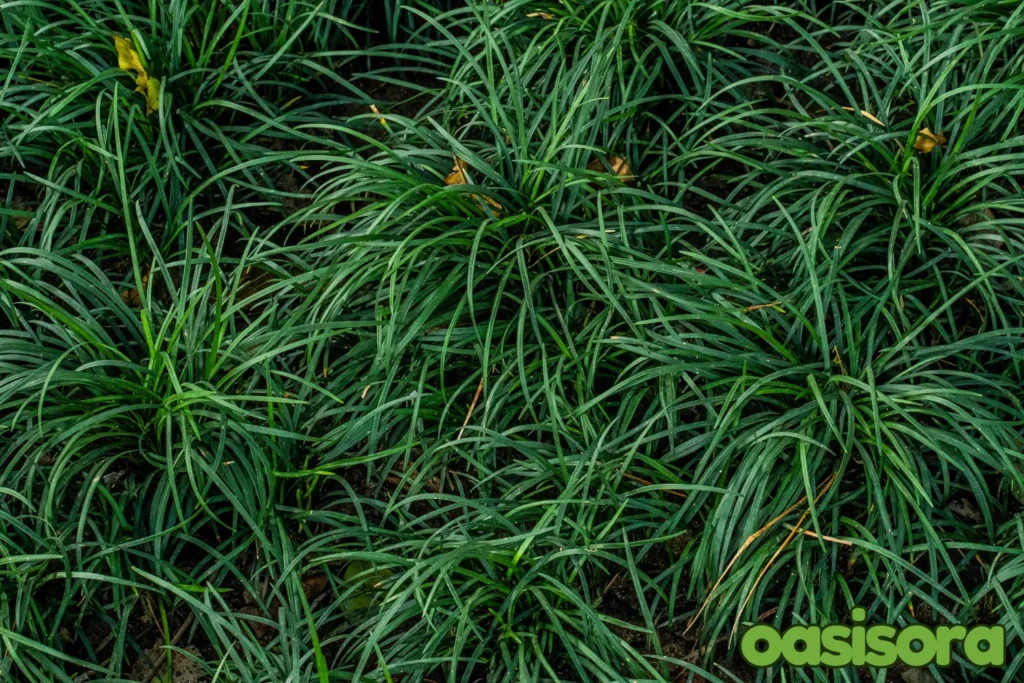
Mondo Grass
Want a ground plant that doesn’t need much care?.
The solution is Mondo Grass! This plant looks like grass and grows in small groups. It spreads out naturally over time, covering the ground with grass-like leaves.
It will look great in your Japanese garden and doesn’t need much care. You can place Mondo Grass between stepping stones, around rocks, or as a low maintenance border to give your garden a finished look.
You can grow this plant because:
- It grows in dry situations and doesn’t need to be watered regularly.
- Can handle both sun and shade.
- Do not cut or mow it; let it grow on its own.
- It doesn’t need special attention because pests and diseases cannot damage it.
8) Japanese Painted Fern (Athyrium niponicum)

Japanese Painted Fern
The Japanese Painted Fern is bright and simple to grow. This fern shines in a Japanese garden due to its soft purple and red leaves that are a shade of pale green
. It is great for adding color and soft texture without much work. You can place Japanese Painted Fern near rocks, paths, or ponds to make your garden feel like a peaceful forest.
You can grow this plant because:
- It does best in shade, so it’s great for putting under trees.
- Once grown, it doesn’t need much water.
- No need to prune, just let it grow on its own.
- It can grow in a variety of regions with little care.
9) Japanese Quince (Chaenomeles japonica)
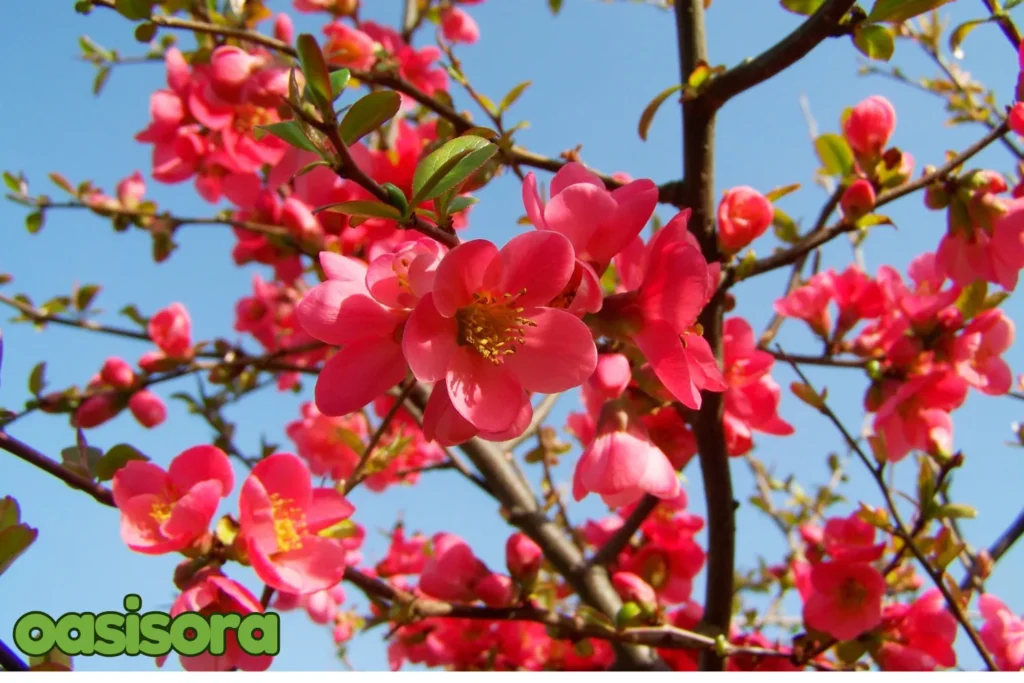
Japanese Quince
Japanese quince is perfect for picking a vibrant plant with little maintenance. Every winter, all leaves of this plant fall off but return in early April with bright red, orange, or pink blooms.
You can put Japanese Quince next to fences, and paths, or in a small garden corner for a colorful spring show.
You can grow this plant because:
- It can grow in full sun or some shade.
- Once grown, it can handle drought.
- Not much cutting is needed.
- Growing well in different types of soil as long as it drains well.
10) Bamboo (Phyllostachys spp.)
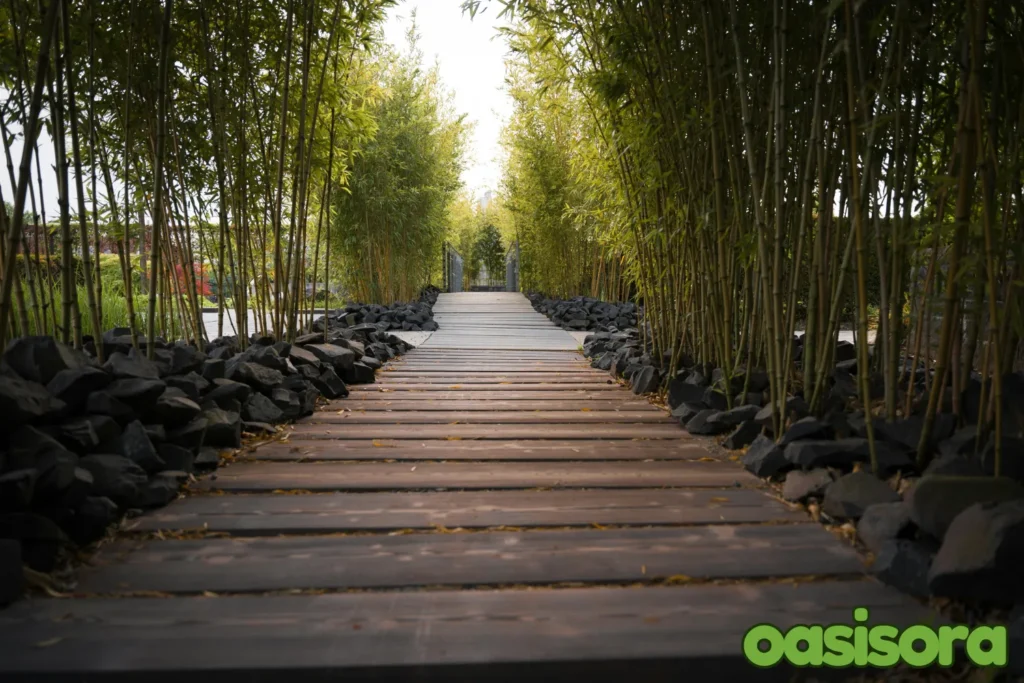
Bamboo
Japanese gardeners love bamboo because it grows quickly. Moreover, they are ideal for creating natural walls. Pots can be used to grow bamboo so it doesn’t spread too far.
Your Japanese garden would be great to set up a quiet and private area.
You can grow this plant because:
- Growing quickly, so it takes up a lot of space very quickly.
- Little watering is required.
- It has a fresh look and stays green all year.
- Pest and disease-resistant.
11) Japanese Camellia (Camellia japonica)

Japanese Camellia
The Japanese Camellia is a great pick if you want beautiful flowers and greenery all year. This plant stays green all year.
Its bright flowers bloom big in the winter and early spring when most plants are dormant. Japanese Camellias look great next to rocks, paths, or water features in a Japanese garden.
You can grow this plant because:
- It is best in some shade but can handle some sun too.
- Don’t require trimming.
- Once grown, it doesn’t need much water.
- A little acidic, well-drained soil is best for this plant.
12) Japanese Iris (Iris ensata)

Japanese Iris (Iris ensata)
The Japanese Iris is a beautiful flower that comes in many colors. These beautiful plants like water grow in shades of purple, blue, and white, making the environment feel soft and peaceful.
Their favorite places are wet ones, but they don’t need much care. If you don’t have a pond, your Japanese Iris will still do very well if you keep the soil slightly wet.
You can grow this plant because:
- It grows best near ponds, streams, or wet ground.
- Can handle a little sunlight.
- Once grown, it doesn’t need much care.
- It comes back every year with new flowers.
13) Japanese Andromeda (Pieris japonica)

Japanese Andromeda
This evergreen shrub grows quickly and is excellent for areas that get some shade. It has tough green leaves that turn brown or red in the spring.
It also has groups of tiny white flowers resembling bells hanging from the branches. It adds texture and beauty to your garden without much work.
Japanese Andromeda can be planted with little effort in shady spots or beneath larger trees to provide a natural appearance.
You can grow this plant because:
- Fits well in places with little light because it likes shade or partial sun.
- Not much trimming is needed.
- Likes slightly acidic soil that drains well.
- Not easily damaged by bugs and infections.
14) Japanese Lantern (Physalis alkekengi)

Japanese Lantern
Japanese Lantern is an excellent choice if you want to do something different and interesting. This pretty plant gets its name from the bright orange husks that look like paper that cover its berries in the late summer and fall.
It gives your garden a pop of color and an interesting shape with little work. Japanese Lantern is a fun and pretty way to decorate your garden. Its colorful seeds can also be dried and used as pretty decorations inside.
You can grow this plant because:
- This plant does well in both full sun and some shade.
- Not much watering is needed once it is grown.
- Exists in different types of soil as long as it drains well.
- Returns every year without having to be replanted.
Key Takeaways
- Choose low maintenance Japanese garden plants so you won’t have to spend much time taking care of them.
- Watering plants correctly and using soil that drains well are both good for their health.
- Your garden’s sunlight, soil, and climate will assist in your plant selection.
- Many beautiful plants, like bamboo, Japanese forest grass, and small Japanese maple, need little maintenance.
- Combining trees, shrubs, plants, and flowers will improve the look and tranquility of your outdoor space.
Benefits of Low Maintenance Japanese Garden Plants
A Japanese garden should be calm and beautiful, not something that takes hours of hard work. Low maintenance plants are the ideal choice. All year long, they still look fantastic; they save time and require less maintenance.
- Less Time-Consuming
These plants grow on their own without daily attention. You won’t have to spend time looking after the bugs, watering, or pruning. Put them in the proper location; they will flourish with little work.
- Low Watering and Fertilization Needs
Once these plants grow up, they require little regular watering. They usually need no additional fertilizer and can flourish in many soil varieties. This will improve the ecology around your garden and simplify its maintenance.
- Ideal for Beginner Gardeners
If you’ve never planted before, these are fantastic. They require little care because they are strong and easy to develop. Despite the minimal gardening experience, these plants will help you design a beautiful and peaceful Japanese garden.
Essential Care Tips for Low Maintenance Japanese Garden Plants
Every plant requires little care and love to grow. Yes, low maintenance Japanese garden plants also need your love and a little attention. Your love and care make them more attractive and healthy.
The good thing is that it is quick and easy to do. Follow these easy rules to help your Japanese garden look fantastic with minimal effort.
Proper Watering Practices
Plants must be watered correctly to stay healthy and productive. If plant roots get too much water, they will decay; if they lack enough, they will dry out.
Tips for Giving the Right Amount of Water:
- This helps roots grow deeper and makes plants stronger. But don’t water too much.
- It’s time to water if the top inch of dirt feels dry.
- Add a layer of mulch. It helps maintain moisture in and lower water demand by surrounding plants.
When the weather is right, Japanese garden plants must only be watered once or twice a week. When it is hot outside, they might need a little more.
Soil and Fertilization Needs
A healthy garden starts with good soil. Japanese plants do best in soil that drains quickly and doesn’t keep the roots too wet.
Japanese plants do best in this soil:
- Sand or loamy soil works best because it holds water but doesn’t stay too wet.
- You don’t have to use as much fertilizer because waste and other organic materials are enough for the soil.
- Roots can get hurt by heavy clay soil that keeps too much water.
Many plants that don’t need much care don’t need a lot of fertilizer. For steady growth, feed them with an organic fertilizer that breaks down slowly in the spring.
Pruning and Maintenance
Trimming helps plants keep their shape. The best part is that most low maintenance Japanese plants need very little pruning.
Simple Ways to Trim:
- As little as once or twice a year is enough.
- Do not leave stems that are dead or damaged on plants.
- Keep the natural beauty of shrubs and trees by lightly shaping them.
- Don’t hurt the plant; use clean, sharp tools instead.
Simply cut off the dead leaves of grasses and plants in early spring to make space for new growth.
Additional Low Maintenance Japanese Garden Plants (Optional for Added Variety)
- Moss is a soft, green plant that grows independently in the shade.
- Add some gravel and sand and give it a Zen look; you don’t have to water it.
- Make stone paths in your garden. They look natural and don’t need any maintenance.
- Bamboo fountains are an easy way to add peace with water.
- Stepping stones make the garden look nice and don’t need much care.
Conclusion:
Creating a Low Maintenance Japanese Garden
A Japanese garden is beautiful and peaceful and don’t need great effort to set up. You can create a stunning garden by choosing low maintenance plants like Dwarf Japanese Maple, Bamboo, and Japanese Forest Grass.
These plants need minimal effort. Adding gravel, moss, stepping stones, or bamboo ponds to your garden is an easy way to give it a traditional Japanese look.
Remember to choose plants that fit your garden design and temperature. Making the correct decisions will help you enjoy a neat, elegant garden that remains simple and attractive all year.

3 thoughts on “14 Best Low Maintenance Japanese Garden Plants For 2025”
Comments are closed.